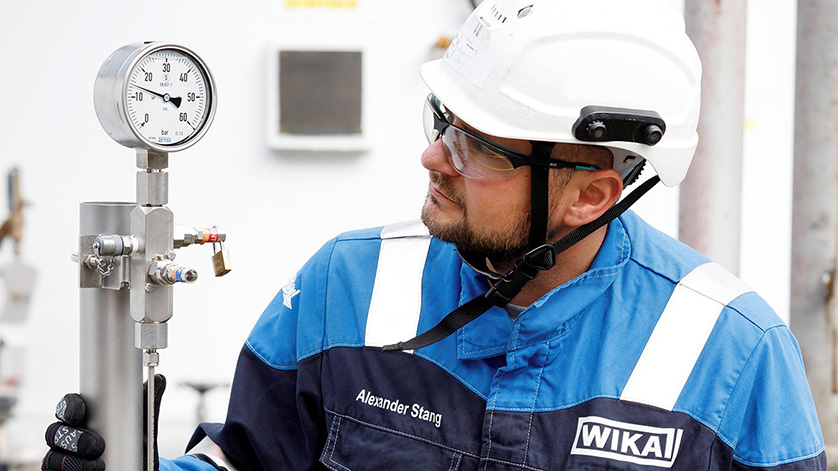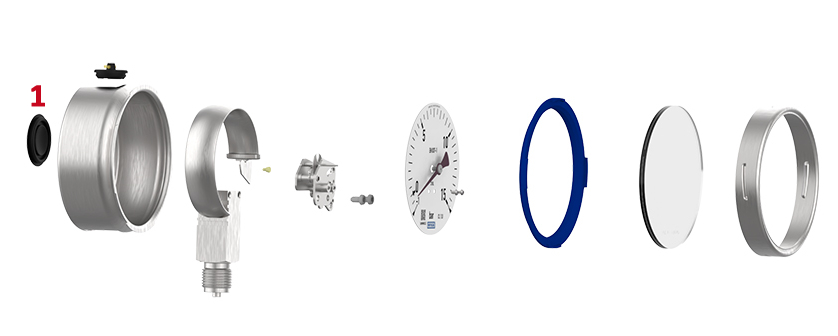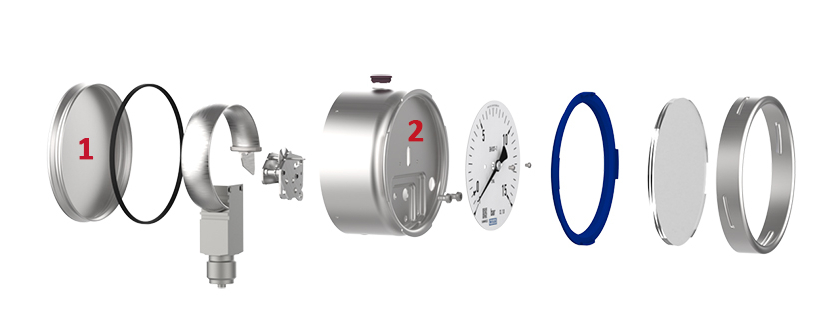
Pressure gauges in safety version made from stainless steel are of great importance, especially for critical processes in the process industry. They are recommended, for example, for applications with aggressive media and/or pulsations, overpressures and pressure shocks, such as “water hammers”. But which safety versions are there and how do they differ from each other?
The answer to this question can be illustrated using the most frequently requested stainless steel Bourdon tube pressure gauges from WIKA, models 232.50/233.50 and 232.30/233.30. Both are often colloquially referred to as “chemical pressure gauges”. In other words, they are designed for high requirements and therefore offer everything that customers need, especially for safety-related processes.
Safety version of level S1

Construction of a model 232.50/233.50 pressure gauge in safety version of level S1 with blow-out device/blow-out plug (1)
The 232.50/233.50 pressure gauge has a blow-out device in the rear of the case in accordance with the EN 837-1 standard. It therefore corresponds to the safety version S1. Should the Bourdon tube burst in the event of a fault, a large part of the released energy can escape to the rear via the blow-out plug. However, this design does not prevent the window, other components and the medium being ejected forwards from the housing in the event of a particularly violent and sudden burst of energy – for example when a valve is opened quickly. This, in turn, can cause serious injury to anyone standing in front of the instrument at that moment.
Safety version of level S3

Construction of a model 232.30/233.30 pressure gauge in safety version of level S3 with blow-out back (1) and solid baffle wall (2)
The 232.30/233.30 pressure gauge is qualified as an instrument with safety version S3 in accordance with the standard and therefore offers the greatest possible protection in the event of a fault. It is marked accordingly by a circled “S” on the dial. The safety features of the case are a solid baffle wall and a blow-out back. Consequently, in the event of a burst Bourdon tube, any components and the medium can only escape to the rear. Operating personnel in front of the instrument are therefore always protected.
Decision guidance for users
The following overview is intended to give users advice, taking into account the EN 837-2 standard (Selection and installation recommendations for pressure gauges), about in which cases which safety version is advisable.
- Applications with liquid process medium:
S1 for pressure gauges with case filling
(in accordance with EN 837-2, no safety version is necessary for instruments without case filling) - Applications with gaseous process media:
S1 for scale ranges ≤ 25 bar
S3 for scale ranges > 25 bar
At this point it should be emphasised once again: Wherever a pressure gauge cannot be protected from critical process events (pressure peaks, pulsations, overpressure, etc.) by appropriate protective measures, a safety version of the highest level (S3) is generally recommended.
The standard also specifies another safety version for pressure gauges, level S2 (with a blow-out back, but without a solid baffle wall). With stainless steel pressure gauges, however, WIKA concentrates on the other two safety levels due to decades of market and customer experience.
Note
Further information on the model 232.50/233.50 and 232.30/233.30 pressure gauges is available on the WIKA website. You will also find comprehensive compilations of measurement solutions for the individual branches of the process industry. If you have any questions, your contact will gladly help you.
Also read our posts
Pressure gauges and hydrogen: Which instruments are suitable?
Pressure measuring system against fugitive methane emissions
Overload safety of Bourdon tube pressure gauges
Filling liquids in pressure gauges: Usage and advantages
Bourdon tube pressure gauge – functional principle

